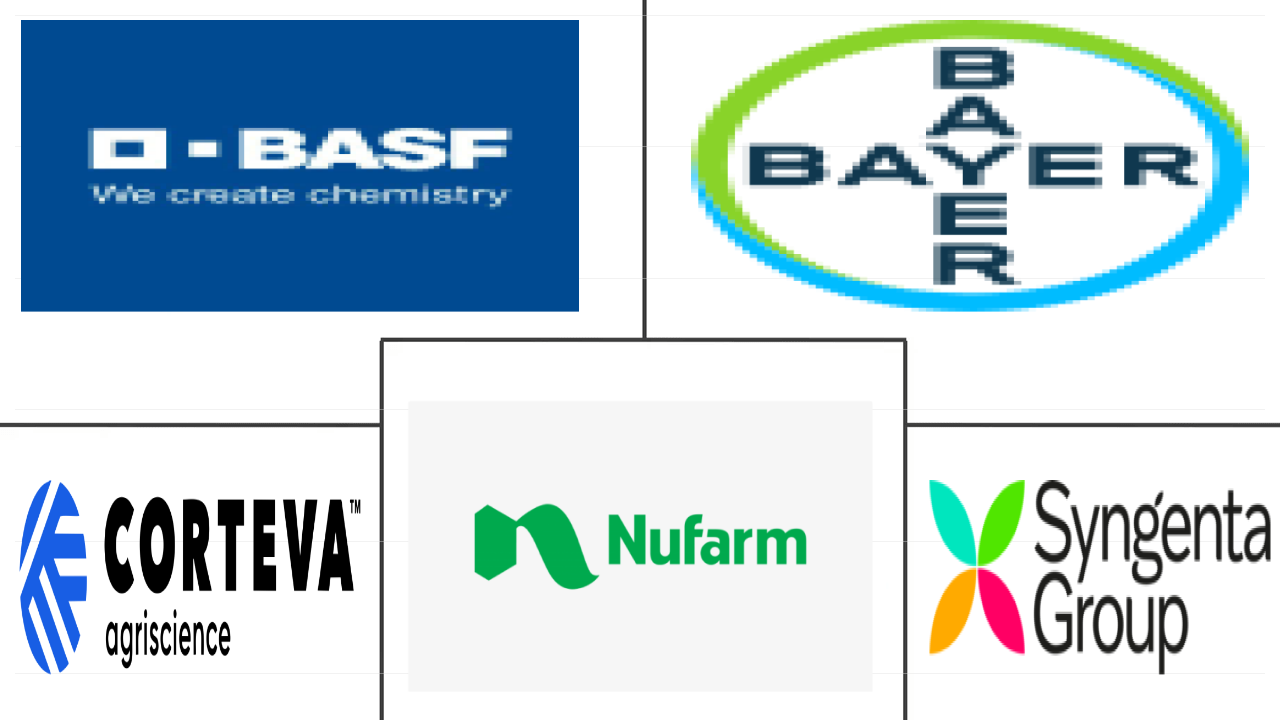Market Size of herbicide Industry
| Icons | Lable | Value |
|---|---|---|
|
|
Study Period | 2017 - 2029 |
|
|
Market Size (2024) | USD 41.32 Billion |
|
|
Market Size (2029) | USD 53.17 Billion |
|
|
Largest Share by Application Mode | Soil Treatment |
|
|
CAGR (2024 - 2029) | 5.18 % |
|
|
Largest Share by Region | South America |
|
|
Market Concentration | High |
Major Players |
||

|
||
|
*Disclaimer: Major Players sorted in no particular order |
Herbicide Market Analysis
The Herbicide Market size is estimated at 41.32 billion USD in 2024, and is expected to reach 53.17 billion USD by 2029, growing at a CAGR of 5.18% during the forecast period (2024-2029).
41.32 Billion
Market Size in 2024 (USD)
53.17 Billion
Market Size in 2029 (USD)
5.51 %
CAGR (2017-2023)
5.18 %
CAGR (2024-2029)
Largest Segment by Application Mode
48.30 %
value share, Soil Treatment, 2023
Herbicides can be applied with precision through the soil treatment method, targeting areas where weed pressure is high, thereby optimizing herbicide use.
Largest Segment by Crop Type
45.66 %
value share, Grains & Cereals, 2023
The rising demand for herbicides, the increasing need for high agricultural productivity, and the increasing international demand for grains and cereals drive the market.
Largest Segment By Region
35.62 %
value share, South America, 2023
The rising crop losses, the need to protect crops, increasing awareness of weed control, and rising demand for agriculture products are driving the market.
Fastest-growing Segment by Country
9.06 %
Projected CAGR, India, 2024-2029
Factors like labor shortage, increased wages, and problems associated with manual weeding practices may drive the herbicides market in the country.
Leading Market Player
23.19 %
market share, Bayer AG, 2022

Bayer has partnered with Oerth Bio to develop next-generation crop protection products based on Oerth Bio's innovative protein degradation technology.
Soil application dominates the global herbicide market
- Weeds are a major contributor to yield loss and reduced quality in an agricultural system. They compete with the crop for resources like light, water, and nutrients. Weeds can also harm crop plants by acting as reservoirs for destructive plant pathogens, the insect vectors that move these pathogens from plant to plant, or both. The use of herbicides is the most effective weed management tool, as it is cheaper, more reliable, and more labor- and time-saving than other weed control measures. Several herbicide application techniques can be used to control herbaceous weeds, trees, and bushes of various sizes.
- Soil application dominated the global herbicide market, accounting for a market share of 48.4% in 2022. Pre-emergence herbicides can be applied through soil treatment. By reducing weed pressures early on, crops can get off to a strong start during the cropping season. With different active ingredients and application timings, soil-active herbicides can help tackle troublesome resistant weeds and slow down the development of herbicide resistance.
- Foliar application accounted for 30.3% of the global herbicide market value in 2022. Post-emergence herbicides can be applied through this method. A post-emergence herbicide must move from the leaf surface and reach the target site to be effective. Following the foliar method, chemigation accounted for 19.6% of the global herbicide market in 2022.
- In the agricultural sector, herbicide usage optimizes crop productivity and enhances overall profitability. The usage of herbicides is expected to register a CAGR of 5.1% during the forecast period (2023-2029).
Rising crop losses due to the weeds are expected to boost the demand for herbicides
- Weeds are a major biotic constraint to production in different cropping systems. Yield losses in crops due to weeds depend on several factors, such as weed emergence time, weed density, type of weeds, and crop types. Weeds can result in 100% yield loss if left uncontrolled. Herbicides are an integral part of weed control globally.
- In 2022, South America accounted for a market share of 35.5%, by value, of the global herbicide market. The herbicide market in South America is experiencing growth in various countries, including Argentina, Brazil, Chile, and the rest of South American countries. As these countries are major agricultural producers with vast expanses of farmland, the use of herbicides is crucial to manage weed populations and ensure optimal crop yields. The South American herbicide market is projected to record a CAGR of 5.2% during the forecast period (2023-2029.
- North America accounted for 31.6%, by value, of the global herbicide market in 2022. North America's diverse climate allows for the cultivation of a wide range of crop types across the region. North Americans cultivate grains, legumes, fruits, vegetables, and ornamental plants. Primetime farmers mostly practice monoculture, i.e., cultivating a single crop for their primary income in a very large area, leading to an increase in weed infestation and reduced yields. Johnsongrass, barnyard grass, Palmer amaranth, and prickly sid are major weeds found in the region.
- The global herbicide market is projected to register a CAGR of 5.1% during the forecast period (2023-2029). The rising crop losses, the need to protect crops, increasing awareness of weed control, and rising demand for agriculture products are driving the market's growth.
Herbicide Industry Segmentation
Chemigation, Foliar, Fumigation, Soil Treatment are covered as segments by Application Mode. Commercial Crops, Fruits & Vegetables, Grains & Cereals, Pulses & Oilseeds, Turf & Ornamental are covered as segments by Crop Type. Africa, Asia-Pacific, Europe, North America, South America are covered as segments by Region.
- Weeds are a major contributor to yield loss and reduced quality in an agricultural system. They compete with the crop for resources like light, water, and nutrients. Weeds can also harm crop plants by acting as reservoirs for destructive plant pathogens, the insect vectors that move these pathogens from plant to plant, or both. The use of herbicides is the most effective weed management tool, as it is cheaper, more reliable, and more labor- and time-saving than other weed control measures. Several herbicide application techniques can be used to control herbaceous weeds, trees, and bushes of various sizes.
- Soil application dominated the global herbicide market, accounting for a market share of 48.4% in 2022. Pre-emergence herbicides can be applied through soil treatment. By reducing weed pressures early on, crops can get off to a strong start during the cropping season. With different active ingredients and application timings, soil-active herbicides can help tackle troublesome resistant weeds and slow down the development of herbicide resistance.
- Foliar application accounted for 30.3% of the global herbicide market value in 2022. Post-emergence herbicides can be applied through this method. A post-emergence herbicide must move from the leaf surface and reach the target site to be effective. Following the foliar method, chemigation accounted for 19.6% of the global herbicide market in 2022.
- In the agricultural sector, herbicide usage optimizes crop productivity and enhances overall profitability. The usage of herbicides is expected to register a CAGR of 5.1% during the forecast period (2023-2029).
| Application Mode | |
| Chemigation | |
| Foliar | |
| Fumigation | |
| Soil Treatment |
| Crop Type | |
| Commercial Crops | |
| Fruits & Vegetables | |
| Grains & Cereals | |
| Pulses & Oilseeds | |
| Turf & Ornamental |
| Region | |||||||||||||||
| |||||||||||||||
| |||||||||||||||
| |||||||||||||||
| |||||||||||||||
|
Herbicide Market Size Summary
The herbicide market is poised for significant growth, driven by the increasing need for effective weed management in agriculture. Weeds pose a substantial threat to crop yield and quality by competing for essential resources and acting as reservoirs for pests and pathogens. Herbicides offer a cost-effective and efficient solution for controlling weeds, making them an integral part of modern agricultural practices. The market is characterized by various application techniques, with soil application leading the market, followed by foliar and chemigation methods. The rising demand for herbicides is fueled by the need to optimize crop productivity and profitability, particularly in regions with extensive agricultural activities such as South America and North America.
The global herbicide market is experiencing a robust expansion, with a steady increase in consumption per hectare due to the adaptability and rapid reproduction of weeds. This has led to a heightened reliance on herbicides to maintain agricultural productivity. South America holds a significant share of the market, driven by large-scale crop production and intensive farming practices. The market is also witnessing the introduction of advanced herbicide products and partnerships aimed at enhancing crop protection and developing eco-friendly solutions. Major players in the market, including BASF SE, Bayer AG, Corteva Agriscience, Nufarm Ltd, and Syngenta Group, continue to dominate the landscape, contributing to the market's consolidation and ongoing innovation.
Herbicide Market Size - Table of Contents
-
1. MARKET SEGMENTATION (includes market size in Value in USD and Volume, Forecasts up to 2029 and analysis of growth prospects)
-
1.1 Application Mode
-
1.1.1 Chemigation
-
1.1.2 Foliar
-
1.1.3 Fumigation
-
1.1.4 Soil Treatment
-
-
1.2 Crop Type
-
1.2.1 Commercial Crops
-
1.2.2 Fruits & Vegetables
-
1.2.3 Grains & Cereals
-
1.2.4 Pulses & Oilseeds
-
1.2.5 Turf & Ornamental
-
-
1.3 Region
-
1.3.1 Africa
-
1.3.1.1 By Country
-
1.3.1.1.1 South Africa
-
1.3.1.1.2 Rest of Africa
-
-
-
1.3.2 Asia-Pacific
-
1.3.2.1 By Country
-
1.3.2.1.1 Australia
-
1.3.2.1.2 China
-
1.3.2.1.3 India
-
1.3.2.1.4 Indonesia
-
1.3.2.1.5 Japan
-
1.3.2.1.6 Myanmar
-
1.3.2.1.7 Pakistan
-
1.3.2.1.8 Philippines
-
1.3.2.1.9 Thailand
-
1.3.2.1.10 Vietnam
-
1.3.2.1.11 Rest of Asia-Pacific
-
-
-
1.3.3 Europe
-
1.3.3.1 By Country
-
1.3.3.1.1 France
-
1.3.3.1.2 Germany
-
1.3.3.1.3 Italy
-
1.3.3.1.4 Netherlands
-
1.3.3.1.5 Russia
-
1.3.3.1.6 Spain
-
1.3.3.1.7 Ukraine
-
1.3.3.1.8 United Kingdom
-
1.3.3.1.9 Rest of Europe
-
-
-
1.3.4 North America
-
1.3.4.1 By Country
-
1.3.4.1.1 Canada
-
1.3.4.1.2 Mexico
-
1.3.4.1.3 United States
-
1.3.4.1.4 Rest of North America
-
-
-
1.3.5 South America
-
1.3.5.1 By Country
-
1.3.5.1.1 Argentina
-
1.3.5.1.2 Brazil
-
1.3.5.1.3 Chile
-
1.3.5.1.4 Rest of South America
-
-
-
-
Herbicide Market Size FAQs
How big is the Global Herbicide Market?
The Global Herbicide Market size is expected to reach USD 41.32 billion in 2024 and grow at a CAGR of 5.18% to reach USD 53.17 billion by 2029.
What is the current Global Herbicide Market size?
In 2024, the Global Herbicide Market size is expected to reach USD 41.32 billion.

